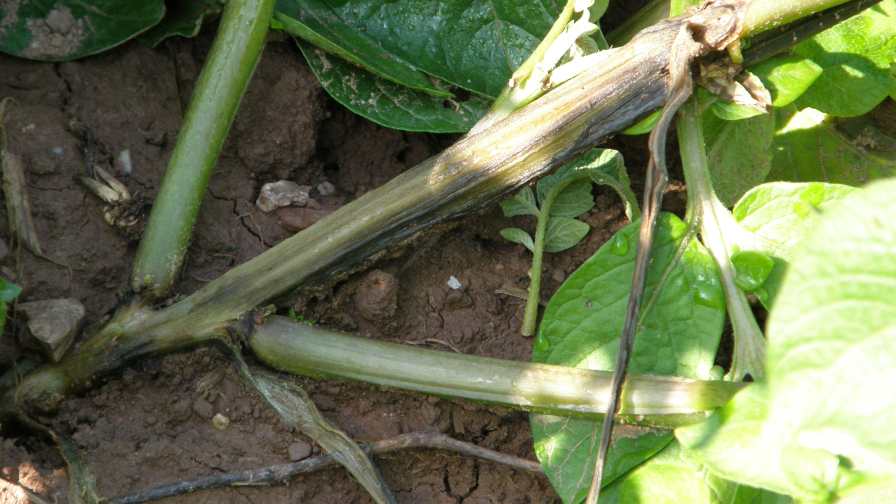Dickeya dianthicola: A New Threat To Potatoes

Fields infected with Dickeya have uneven emergence, raggedy stands, and there may be 10% to 40% of the plants missing. Photo credit: Steve Johnson
Dickeya dianthicola has emerged to be a considerable threat to potatoes within the last couple years, leaving many growers with significantly reduced stands and very few control options.
Until May 2014, the seedborne pathogen had been improperly identified in many growers’ fields, often being labeled as blackleg, or Pectobacterium atrosepticum.
According to Steve Johnson, Crop Specialist from the University of Maine, growers along the Eastern Seaboard were reporting increased incidences of blackleg-like symptoms in potatoes until the pathogen in question was properly identified as D. dianthicola in 2014.
Confusion With Blackleg
Although symptoms for D. dianthicola and blackleg are similar, Johnson explains the biology behind the two diseases is much different, and Dickeya is far more aggressive than blackleg.
“Dickeya dianthicola differs from pectobacterium in the sense that it likes warmer conditions, it causes disease at a much lower level of bacteria than does pectobacterium, and it’s much more damaging than blackleg,” Johnson explains.
According to Johnson, because Dickeya prefers warmer temperatures than blackleg, it reproduces the fastest at 75°F or 77°F.
Aboveground symptoms include blackness in the stem that rises from the bottom up, which tends to hollow the stem from the inside out. The color tends to be more brown than black, and often is a slimier texture than pectobacterium.
“The plant can wilt very quickly, and wilting can occur throughout the whole growing season,” Johnson explains.
“Pectobacterium tends to spread with wind-blown rain and infect from the top down. With Dickeya, it works from the inside out versus the outside in,” he says.
Andy Wyenandt, Extension Specialist in vegetable pathology at Rutgers University, who has worked alongside growers managing D. dianthicola in New Jersey, explains that the pathogen is actually a part of another group of pathogens, which originated from bacterial soft rot and split apart based on its DNA.
“A lot of people want to group Dickeya dianthicola with other blackleg pathogens, which aren’t as severe and aren’t as destructive, and that’s part of the problem,” Wyenandt says.
Symptoms And Prevalence
According to Johnson, aboveground symptoms include fields that have uneven emergence and “raggedy” stands.
“There may be 10% to 40% of the plants missing, and this can occur with no black stems whatsoever — they may have simply never come out of the ground, or they came out of the ground and just didn’t look good,” he says.
However, the tubers may develop symptoms later on including a light-colored rot with no odor, differing from blackleg, which produces a much more distinct smell.
Firsthand Experience
Mike Brooks, President of the New Jersey Potato Growers Association and grower at Dusty Lane Farms in New Jersey, has witnessed firsthand the devastating effects of Dickeya.
“We have 120 acres that are confirmed to be infected with Dickeya. It’s anywhere from a 5% to 25% rate of infection in the plant that we see showing symptoms,” Brooks explains. He says the seed planted on the farm came from Maine.
Dusty Lane Farms has a total of 300 acres, and although Brooks has not yet harvested his potatoes, he fears yields will be significantly reduced.
“We had one order of seed come in and I saw three or so rotten tubers. I had them sent to our local Extension agent who sent them away for testing, and they came back positive for Dickeya. However, by the time we got the results back, we had already planted the seed in the ground,” Brooks says.
Despite the near-perfect weather conditions, he began to see plants wilting and dying a month and a half later once they were 6 to 8 inches tall.
“When you see that 20% of your plants have been affected, you know you’re going to have some kind of yield loss. But we are harvesting now, and we will evaluate how much of a loss we actually do have,” Brooks says.
Management Practices
D. dianthicola is a seedborne pathogen and, according to Johnson, infected seed pieces often express no symptoms. While there are some tuber tests that can be done before planting, the primary line of defense is to have a zero-tolerance policy for Dickeya when purchasing from your seed dealer, Johnson says.
“There are some thoughts that not cutting seed may help. We are looking into research to confirm or deny this, but not everyone is set up for whole seed,” he explains. Johnson says that varietal testing also is being done, but no conclusions have been drawn yet.
“Across the board, we find it more in some varieties than others, but we don’t know if that is seed source, grower source, or variety susceptibility,” he says. Johnson says also he has looked into crop rotation, but has not yet found any data to support its effectiveness.
Wyenandt expresses a similar sentiment to Johnson in that the only true management technique begins with seed purchase.
“Our growers have been suffering losses; there’s really nothing they can do. Purchasing clean seed is the place to start. It doesn’t take a whole lot of Dickeya to cause significant loss, so a zero-tolerance policy needs to be instated in my opinion. You shouldn’t be able to find Dickeya on the seed at any level,” he says.
Future Prognosis
Unfortunately, Wyenandt says he believes the prevalence of D. dianthicola will get worse before it gets any better.
“We’ve asked growers to scout their fields and monitor. People like myself can make recommendations, but the regulations around tolerance levels will need to be changed at the state level,” he says.
USDA recently came out and classified D. dianthicola as non-actionable or non-reportable, but according to Wyenandt, it doesn’t mean that it’s not a serious threat to the potato industry.









